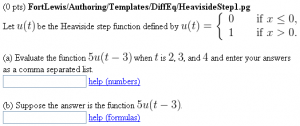Difference between revisions of "HeavisideStep1"
(Created page with '<h2>Using the Heaviside Step Function</h2> 300px|thumb|right|Click to enlarge <p style="background-color:#f9f9f9;border:black solid 1px;padding:3px;"…') |
|||
| Line 3: | Line 3: | ||
[[File:HeavisideStep1.png|300px|thumb|right|Click to enlarge]] |
[[File:HeavisideStep1.png|300px|thumb|right|Click to enlarge]] |
||
<p style="background-color:#f9f9f9;border:black solid 1px;padding:3px;"> |
<p style="background-color:#f9f9f9;border:black solid 1px;padding:3px;"> |
||
| − | This PG code shows how to add a the Heaviside step function <code>step(x)</code>, which takes the value 1 if x > 0, and the value 0 if x & |
+ | This PG code shows how to add a the Heaviside step function <code>step(x)</code>, which takes the value 1 if x > 0, and the value 0 if x ≤ 0, to the context. It also shows how to add a named function <code>u(x)</code> to the context that has a reliable answer checker and can stand in for the Heaviside step function when the student answer is a function. |
</p> |
</p> |
||
* Download file: [[File:HeavisideStep1.txt]] (change the file extension from txt to pg when you save it) |
* Download file: [[File:HeavisideStep1.txt]] (change the file extension from txt to pg when you save it) |
||
| Line 87: | Line 87: | ||
<p> |
<p> |
||
<b>Setup:</b> |
<b>Setup:</b> |
||
| − | We add the (Legacy) step function to the context with the name <code>step</code>. The function <code>step(t)</code> takes the value 1 when t > 0, and the value 0 when t & |
+ | We add the (Legacy) step function to the context with the name <code>step</code>. The function <code>step(t)</code> takes the value 1 when t > 0, and the value 0 when t ≤ 0. Using <code>parserFunction.pl</code>, we add another function named <code>u(x)</code> to the context. The reason for adding these two functions to the context is that |
* <code>step</code>, which is the Heaviside function, will be used when the answer is a number |
* <code>step</code>, which is the Heaviside function, will be used when the answer is a number |
||
Revision as of 03:03, 6 December 2010
Using the Heaviside Step Function
This PG code shows how to add a the Heaviside step function step(x), which takes the value 1 if x > 0, and the value 0 if x ≤ 0, to the context. It also shows how to add a named function u(x) to the context that has a reliable answer checker and can stand in for the Heaviside step function when the student answer is a function.
- Download file: File:HeavisideStep1.txt (change the file extension from txt to pg when you save it)
- File location in NPL:
FortLewis/Authoring/Templates/DiffEq/HeavisideStep1.pg
| PG problem file | Explanation |
|---|---|
|
Problem tagging: |
|
DOCUMENT(); loadMacros( "PGstandard.pl", "MathObjects.pl", "AnswerFormatHelp.pl", "parserFunction.pl", ); TEXT(beginproblem()); |
Initialization:
We load |
Context("Numeric");
Context()->variables->are(t=>"Real");
Context()->functions->add(
step => {
class => 'Parser::Legacy::Numeric',
perl => 'Parser::Legacy::Numeric::do_step'
},
);
parserFunction("u(t)" => "1.5*sin(e*t)+2*pi/e");
$f = Formula("5*step(t-3)");
$g = Formula("5*u(t-3)");
$answer1 = List($f->eval(t=>2),$f->eval(t=>3),$f->eval(t=>4));
$answer2 = $g;
|
Setup:
We add the (Legacy) step function to the context with the name
Since answers are checked numerically by comparing the student answer to the correct answer at several points in the domain (the default is 5 points) in an interval (the default is [-1,1]), the function
Notice that the function |
Context()->texStrings;
BEGIN_TEXT
Let \( u(t) \) be the Heaviside step function
defined by
\( \displaystyle
u(t) =
\left\lbrace
\begin{array}{lcl}
0 && \mbox{ if } x > 0, \\
1 && \mbox{ if } x \leq 0.
\end{array}
\right.
\)
$BR
$BR
(a) Evaluate the function \( $g \) when
\( t \) is 2, 3, and 4 and enter your answer
as a comma separated list.
$BR
\{ ans_rule(20) \}
\{ AnswerFormatHelp("numbers") \}
$BR
$BR
(b) Enter the function \( $g \).
$BR
\{ ans_rule(20) \}
\{ AnswerFormatHelp("formulas") \}
END_TEXT
Context()->normalStrings;
|
Main Text: |
$showPartialCorrectAnswers=1; ANS( $answer1->cmp(ordered=>1) ); ANS( $answer2->cmp() ); |
Answer Evaluation: |
Context()->texStrings;
BEGIN_SOLUTION
${PAR}SOLUTION:${PAR}
Solution explanation goes here.
END_SOLUTION
Context()->normalStrings;
COMMENT('MathObject version.');
ENDDOCUMENT();
|
Solution: |
